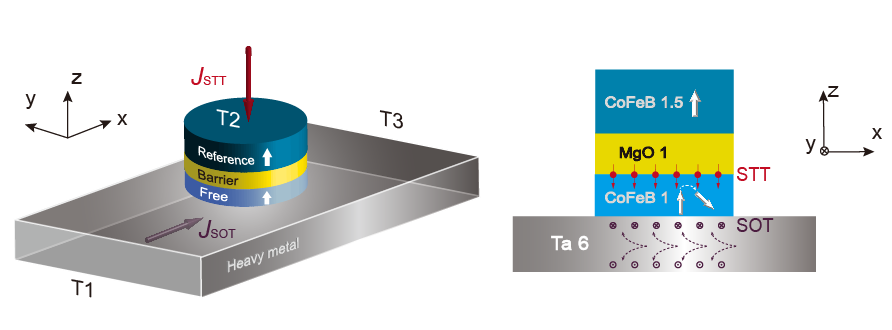On November 12, 2018, the team of Prof. Zhao Weisheng published a research article entitled “Field-free switching of a perpendicular magnetic tunnel junction through the interplay of spin–orbit and spin-transfer torques” in Nature Electronics online. Wang Mengxing, a doctoral student graduated in 2017, Cai Wenlong, a postgraduate enrolled in 2016, Zhu Daoqian, a doctoral student enrolled in 2017 and Wang Zhaohao, an assistant professor, are co-first authors. Prof. Zhao Weisheng is the corresponding author, and Beihang University is the signature unit of the first authors. This research is supported by the Beijing Advanced Innovation Center for Big Data and Brain Computing of Beihang University, the National Natural Science Foundation of China and the National Science and Technology Attack Plan, and it is guided by Prof. Albert Fert from University of Paris-Saclay, Prof. Jian-PingWang from University of Minnesota, Jimmy Kanand Chando Park from Qualcomm Technologies, etc.
In addition, Nature Electronics published an editorial entitled “Devices with a spin” on this research in November, and invited Prof. Pedram Khalili Amiri from the Physical Electronics Laboratory of Northwestern University who is a well-known expert in the field of spintronics to give a special report named “Spin torques join forces in amemory device” in the News & Views section.
The research is the first to demonstrate field-free switching of three-terminal perpendicular-anisotropy magnetic tunnel junction (p-MTJ) devices through the interaction between spin–orbit torques (SOT) and spin-transfer torques (STT). It shows that the threshold current density of SOT switching can be reduced by increasing the STT current density, thus low-power switching in magnetic tunnel junctions can be achieved. It also provides a solution to the excessive area occupied by three-terminal spin-orbit torque memory.
Conventional integrated circuit was based on the transistor technology, which has developed rapidly for more than half a century and boosted the information industry. However, when the size of the devices were further reduced, a lot of problems came up as it failed to fulfill a high level of performance required by some new applications such as big data, cloud computing and internet of things. Spintronics is an important emerging interdisciplinary subject in the past 30 years. It comes up with a novel way of utilizing the spin of electrons instead of charge properties to store and calculate data, thus has great advantages such as non-volatility and radiation resistance.
As one of the core devices of spintronics, p-MTJ has been discussed extensively. At present, there are two main technical means to switch p-MTJ: the use of STT and SOT. STT-MRAM, the core product of STT has a better performance than Flash and enjoys broad application prospects. In 2018, Intel Corporation, Samsung Electronics, Taiwan Semiconductor Manufacturing Company and GLOBALFOUNDRIES, the four leading enterprises in the field of microelectronics manufacturing have announced volume production of STT-MRAM, but are still confronted with technological problems. Although those problems encountered by STT can be solved by SOT, the practical application of SOT is hindered by its symmetry. In recent years, many scholars have been working on this problem and have proposed various solutions, most of which are not compatible with existing magnetic storage technology.
In 2014, the team of Prof. Zhao Weisheng put forward the design of a device combining SOT and STT, which means that SOT rotates the magnetic torque to the inside and STT break the symmetry of SOT in order to achieve deterministic switching of p-MTJs. This plan does not require any modification to the structure or materials of traditional SOT devices, and it is completely compatible with magnetic storage technology and easy to manufacture, so its prospect in application is broad. After four years of hard work. the team of Prof. Zhao Weisheng have succeeded in the design and manufacture of SOT device with Ta/CoFeB/MgO/CoFeB as its core. They first verified the feasibility of SOT+STT internationally. The research results have been patented in the U.S. and possess great potential in application.

SOT+STT scheme and core structure of the device
The research article:
https://www.nature.com/articles/s41928-018-0160-7
Reported by Zhu Daoqian
Edited by Jia Aiping and Lu Baihui
Reviewed by Zhao Weisheng
Translated by Lu Baihui

